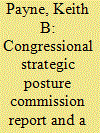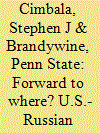| Srl | Item |
| 1 |
ID:
106259


|
|
|
|
|
| Publication |
2011.
|
| Summary/Abstract |
The bipartisan Congressional Strategy Posture Commission offered numerous recommendations to reduce what it labeled "the nuclear danger." The Obama Administration has pursued some of these recommendations via its policy documents, such as the 2010 Nuclear Posture Review, its budgets, and plans. There is reason, however, for several concerns in this regard. These involve the high priority placed on nuclear force reductions at the potential expense of other national goals, including deterrence and assurance; the maintenance of the flexibility and resilience of the U.S. force posture necessary to meet deterrence and assurance requirements now and in the future; continued support for U.S. strategic defensive capabilities given Russian opposition; and apparent interest among some in the Administration to move increasingly toward what has been termed a policy of Minimum Deterrence.
|
|
|
|
|
|
|
|
|
|
|
|
|
|
|
|
| 2 |
ID:
087672


|
|
|
|
|
| Publication |
2009.
|
| Summary/Abstract |
The year 2009 begins a new security relationship, for better or worse, between Russia and the United States. On the policy menu for both states are carry-forward negotiations and looming deadlines with respect to strategic nuclear arms control. Despite the ups and downs of political relations during the years of the George W. Bush and Vladimir Putin presidencies, the United States and Russia have remained committed to reducing their numbers of operationally deployed, long range nuclear weapons. Those commitments have implications for other issues, including nonproliferation and counterterrorism.
Since politics dominates strategy, the outcome of further negotiations on Russian-American nuclear arms reductions depends upon the character of the political winds that blow between Washington and Moscow. During the latter part of the Bush and Putin presidencies, those winds were Arctic. More favorable westerlies and easterlies permit progress, but what realistic options present themselves for policy makers' consideration? The following discussion considers those options, evaluates their credibility, and considers their possible side effects
|
|
|
|
|
|
|
|
|
|
|
|
|
|
|
|